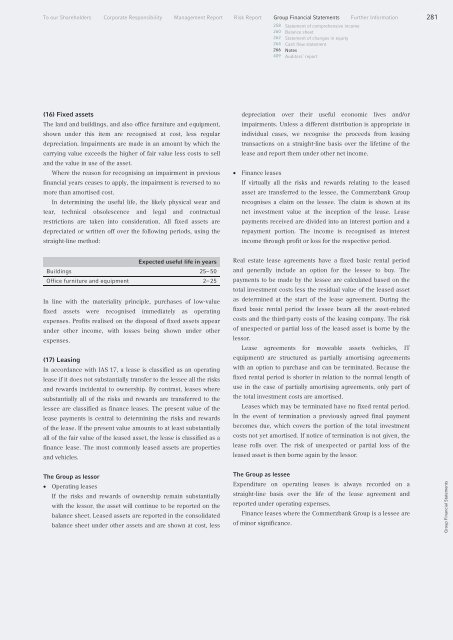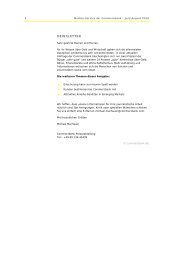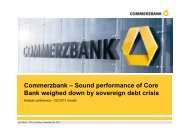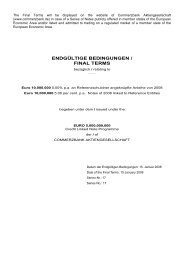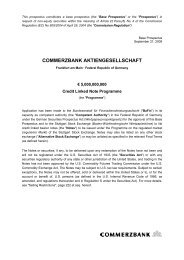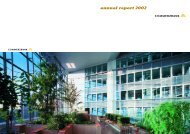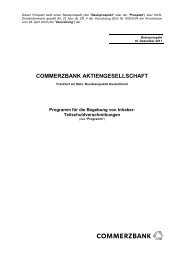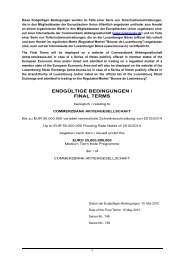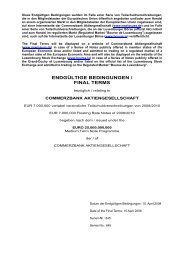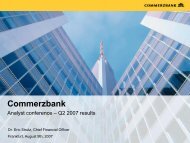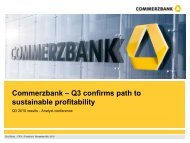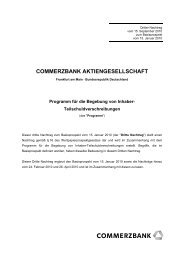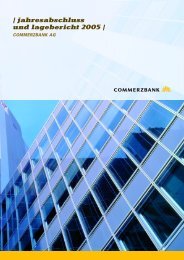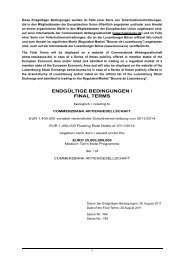COMMERZBANK AKTIENGESELLSCHAFT
COMMERZBANK AKTIENGESELLSCHAFT
COMMERZBANK AKTIENGESELLSCHAFT
Create successful ePaper yourself
Turn your PDF publications into a flip-book with our unique Google optimized e-Paper software.
To our Shareholders Corporate Responsibility Management Report Risk Report Group Financial Statements Further Information 225 281<br />
258 202 Statement of comprehensive income<br />
260 204 Balance sheet<br />
262 206 Statement of changes in equity<br />
264 208 Cash flow statement<br />
266 210 Notes<br />
409 353 Auditors’ report<br />
(16) Fixed assets<br />
The land and buildings, and also office furniture and equipment,<br />
shown under this item are recognised at cost, less regular<br />
depreciation. Impairments are made in an amount by which the<br />
carrying value exceeds the higher of fair value less costs to sell<br />
and the value in use of the asset.<br />
Where the reason for recognising an impairment in previous<br />
financial years ceases to apply, the impairment is reversed to no<br />
more than amortised cost.<br />
In determining the useful life, the likely physical wear and<br />
tear, technical obsolescence and legal and contractual<br />
restrictions are taken into consideration. All fixed assets are<br />
depreciated or written off over the following periods, using the<br />
straight-line method:<br />
Buildings<br />
Expected useful life in years<br />
25– 50<br />
Office furniture and equipment 2– 25<br />
In line with the materiality principle, purchases of low-value<br />
fixed assets were recognised immediately as operating<br />
expenses. Profits realised on the disposal of fixed assets appear<br />
under other income, with losses being shown under other<br />
expenses.<br />
(17) Leasing<br />
In accordance with IAS 17, a lease is classified as an operating<br />
lease if it does not substantially transfer to the lessee all the risks<br />
and rewards incidental to ownership. By contrast, leases where<br />
substantially all of the risks and rewards are transferred to the<br />
lessee are classified as finance leases. The present value of the<br />
lease payments is central to determining the risks and rewards<br />
of the lease. If the present value amounts to at least substantially<br />
all of the fair value of the leased asset, the lease is classified as a<br />
finance lease. The most commonly leased assets are properties<br />
and vehicles.<br />
The Group as lessor<br />
• Operating leases<br />
If the risks and rewards of ownership remain substantially<br />
with the lessor, the asset will continue to be reported on the<br />
balance sheet. Leased assets are reported in the consolidated<br />
balance sheet under other assets and are shown at cost, less<br />
depreciation over their useful economic lives and/or<br />
impairments. Unless a different distribution is appropriate in<br />
individual cases, we recognise the proceeds from leasing<br />
transactions on a straight-line basis over the lifetime of the<br />
lease and report them under other net income.<br />
• Finance leases<br />
If virtually all the risks and rewards relating to the leased<br />
asset are transferred to the lessee, the Commerzbank Group<br />
recognises a claim on the lessee. The claim is shown at its<br />
net investment value at the inception of the lease. Lease<br />
payments received are divided into an interest portion and a<br />
repayment portion. The income is recognised as interest<br />
income through profit or loss for the respective period.<br />
Real estate lease agreements have a fixed basic rental period<br />
and generally include an option for the lessee to buy. The<br />
payments to be made by the lessee are calculated based on the<br />
total investment costs less the residual value of the leased asset<br />
as determined at the start of the lease agreement. During the<br />
fixed basic rental period the lessee bears all the asset-related<br />
costs and the third-party costs of the leasing company. The risk<br />
of unexpected or partial loss of the leased asset is borne by the<br />
lessor.<br />
Lease agreements for moveable assets (vehicles, IT<br />
equipment) are structured as partially amortising agreements<br />
with an option to purchase and can be terminated. Because the<br />
fixed rental period is shorter in relation to the normal length of<br />
use in the case of partially amortising agreements, only part of<br />
the total investment costs are amortised.<br />
Leases which may be terminated have no fixed rental period.<br />
In the event of termination a previously agreed final payment<br />
becomes due, which covers the portion of the total investment<br />
costs not yet amortised. If notice of termination is not given, the<br />
lease rolls over. The risk of unexpected or partial loss of the<br />
leased asset is then borne again by the lessor.<br />
The Group as lessee<br />
Expenditure on operating leases is always recorded on a<br />
straight-line basis over the life of the lease agreement and<br />
reported under operating expenses.<br />
Finance leases where the Commerzbank Group is a lessee are<br />
of minor significance.<br />
Group Financial Statements


